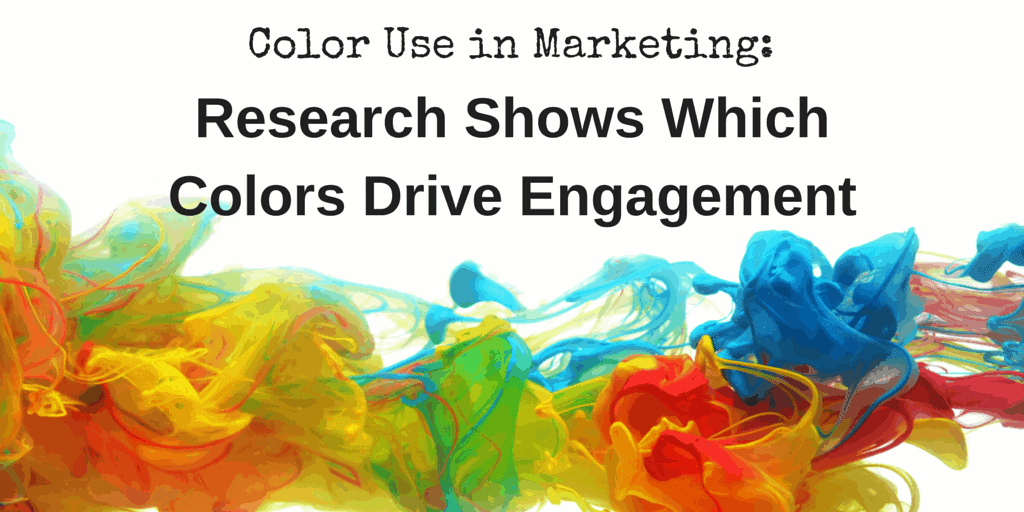It’s something that’s so elementary to any image that we sometimes don’t think much about it. And yet it’s also one of the most important aspects of any image.
Color.
Everyone has heard of the psychological effects color has on us, but how often do you apply those principles in your online marketing images, infographics, and web design? And aside from a vague notion that the color red can make you feel angry, and that blue plates make you eat less, how much do you really know about each color and its powerful influence on our emotions and behavior?
Believe it or not, there are companies whose entire business is composed of finding just the right colors for their clients to use in their marketing collateral, based on research into what those colors denote to each of their clients’ audience demographics. Colors are big business – that’s how vital the right color can be to making or breaking a logo, an ad campaign, or any image.
So without shelling out big bucks for a custom color consultation, how can you figure out which colors would be most effective in your own online marketing efforts?
It’s a complex equation with multiple variables, but there are some standards that apply across the board. These standards are all based on proven psychological principles – but interestingly, age, culture, gender, and even income level can play a major role in how people perceive color, as well. The first step in any color use strategy is to identify your target audience, and do some research into that specific group’s perception of color.
The next step is to read this blog post to learn the basics! We’ve broken things down for you by image type. Because website design, social media images, and infographics serve different purposes in marketing, each one should be approached differently when thinking of which colors to use.
But first, let’s take a look at the way the most common colors are perceived by most people in America.
How Colors Influence Us
Though it’s true that every demographic is influenced by certain colors in different ways, we can still set forth some standards that are usually true for most people – at least in the United States. Once we start talking about other countries, things get more complicated. For example, the color red is associated with danger or risk in the U.S., but in Asia, it’s the color of good luck. Similarly, the color white is associated with purity, innocence, and cleanliness in the West, but it’s actually the color of mourning and death in the East. (This is why it pays to do that research we mentioned above!)
But in the U.S., most people have similar perceptions of what different colors mean, and are influenced by them in the same way, as well. Here are some of the most commonly used colors and their connotations – and effects:
YELLOW
The color yellow usually makes people think of energy, cheerfulness, and sunshine. Its bright hue is great for grabbing attention, but it can also be overwhelming to the eye in large amounts.
ORANGE
Orange is another energetic color, one which projects levity, enthusiasm, and creativity, but also, interestingly, ambition. It can even convey a sense of new beginnings. However, orange has been found to be one of Americans’ least favorite colors, so caution is indicated when using this bold shade.
RED
The color red is a mixed bag. From red stop lights and danger signs to red blood and “seeing red” from anger, we associate the color with many negatives. But red also means power, life, love, and boldness. Used carefully and thoughtfully, this color can have very powerful effects.
BLUE
Did you know that most Americans choose blue as their favorite color? And no wonder – it denotes calm, like the sky and the ocean, as well as productivity, depth, honor and trust. Just imagine what using blue in your company’s color scheme could do for your image!
GREEN
Of course, green means nature, and all things organic and natural. But it is also one of the easiest colors on the eye, and is perceived as communicating safety, harmony, growth, luck, wealth, optimism, and stress relief.
PURPLE
Everyone knows that purple is connected with royalty, power and wealth. But it also conveys a sense of the spiritual. Use this color with caution, though, because it can also project an artificial feel if not used carefully.
BLACK
Black is another color with multiple associations. It can create a sense of luxury and sophistication, and even power and authority. But it can also feel mysterious, or denote death, evil, or gloom. Used correctly, it can be extremely impactful.
BROWN
The color brown evokes feelings of confidence and dependability. It feels solid and down-to-earth. Different hues of brown can also denote elegance. Depending on the image you want to convey, brown can be very useful.
PINK
Pink is, of course, felt to be feminine, but it also has a calming effect. Its usual uses are for conveying affection, love, and tenderness. Be careful not to alienate certain demographics by overusing it, however.
GRAY
Gray is associated with a conservative, serious, traditional feel – but it can also be seen as boring or generic. Be careful when making use of this color to temper its effects with other color, as well.
WHITE
Finally, white conveys purity and youth. It is also a helpful color to use as a backdrop when you want another color to stand out – and white space around text is vital for making it readable and attractive.
COLOR USE IN WEBSITE DESIGN
According to research, people make a subconscious judgment about whatever they see – whether business, website, or product – within 90 seconds of looking at it for the first time. But the real kicker is this: Between 62% and 90% of their assessment is based on color alone. If that doesn’t make the importance of color choice for your website clear, then nothing will!
The first thing to consider when deciding on the color scheme for your website is what feeling you want your brand to convey. Are you a luxury retailer wanting to project elegance and power? Then make black your main color, and maybe throw in some rich purple hues. Are you a solid, customer-friendly company wanting to convey trustworthiness and dependability? Try a mix of blue and brown. The above color descriptions give you the basics.
Beyond these first general associations, however, there are a myriad of other considerations to be taken into account, as well. Which exact shade of blue or purple or green should you use? Who is your audience, and how will they react to those hues? These questions take some research, but getting the right answers is well worth the time.
For example, while blue can be a great color to use on a business site, certain shades of it, such as baby blue, can project a feeling of weakness. Using that shade on a website geared towards new mothers could work well – using it even as an accent color on a B2B site, however, could actually have negative effects.
One of the best ways to discover which colors work best with your particular target audience is to do market research. Test a few different color schemes out on your market, and see how they respond. But there are some helpful generalities that researchers have found that can help steer you in the right direction.
ECO-INSPIRED COLORS
Remember hippies? All those nature-loving flower children have now grown into one of the biggest, most affluent markets in the U.S. – the Baby Boomers – but eco-inspired colors such as greens, blues, and neutrals still appeal to their hippie sensibilities. Any warm, earthy color that reminds people of nature – even metallic and mineral shades – will work well with this audience. Projecting an image of eco-friendliness, interest in the organic, and sustainability will also make your website popular among members of Generation X, or people aged 25-41. This demographic has whole-heartedly embraced the organic movement, so earthen colors speak to them, as well.
COLORS THAT CALM
Targeting successful businesspeople? Then you should clothe your website in rich, calming tones that convey a sense of calm to those stressed out workaholics. Deep hues of brown, purple, gray, and silver project relaxation and luxury, which appeals especially to affluent individuals in the Baby Boomer and Primetime (aged 60 and over) generations.
MODERN, INDUSTRIAL COLORS
Going for that sleek, modern look will gain you attention from Generation X, a group that enjoys a strong, clean aesthetic. Try shades of red, orange, blue, brown, cream, and beige to get that industrial, corporate look.
CYBER COLORS
If your target audience is Generation Y, or Millenials, then bold colors are your best bet. Having grown up in the digital age, this group is used to the bright colors of new technology and vivid hues of video games. Bright whites, blues, aquas, and yellows are the perfect draw for their eyes.
When in doubt, however, with any demographic, experts recommend sticking with safe colors that have safe associations, such as blues and greens, rather than tricky shades like purple and orange.
COLOR USE IN SOCIAL MEDIA IMAGES
Research tells us that 60% of the time, people decide whether they are attracted to a social media marketing message or not based on color alone. So choosing the right colors for that Facebook post image or Pinterest pin is key.
Strangely enough, different colors produce different levels of engagement depending on which social media channel they are used in. A color scheme that works on Facebook may not be as effective on Instagram, and vice versa.
Here’s what research has found. On Pinterest, reddish-orange images get more love, with twice the repins of blue images. But on Instagram, images that are mostly blue get 24% more likes than pictures featuring red as the dominant color. Pinterest users also prefer images with multiple colors sharing the spotlight – these images receive 3.25 times the number of repins as those with only one main color. But on Instagram, images with one single color dominating get 17% more likes. So choose your colors wisely, based on which channel you are using!
Different colors have also been found to have differing levels of success when paired with certain marketing messages. Red, for example, is a great color to use when promoting a sale or special offer, while blue is better for getting likes from large numbers of people. Black is best for images conveying luxury, while pink is popular for being romantic. Orange is best for getting attention, and green is, interestingly, best for images conveying values and ethics.
Follow these guidelines to make your social media images work on every level – even the subconscious one!
COLOR USE IN INFOGRAPHICS
Finally, we come to the infographic. These images are unique in the realm of online marketing, since they seek to share data and statistics in a visually interesting way. Their goal is to give detailed information at a glance, so they contain both numbers and images in order to get their message across most effectively.
Research in this area has recently been done on the use of what are known as “semantically resonant colors.” This simply means that we naturally associate certain colors with certain things or ideas. For example, water and the color blue are linked, as are love and the colors red and pink.
What the research uncovered is that when semantically resonant colors are used in charts, graphs, and infographics, viewers were more easily able to understand them, and thus engaged with them more. The more difficult an image is to take in, the more likely people are to move on – but on the other hand, the more quickly and easily something can be grasped and understood at a glance, the more likely people will be to read the entire thing, and then like or share it.
So for example, using the actual physical colors of items represented in a chart or graph, instead of random colors, instantly makes that chart more understandable. If a chart is representing different flowers, the column for roses could be red, and the one for violets could be blue, etc. Using random colors to represent these commonly known objects doesn’t have nearly the same effect.
The same goes for things that are only metaphorically linked with a color, such as love, or success, or happiness. Using the colors that are semantically resonant with those concepts makes them easier to grasp, and thus, makes the whole infographic more engaging, and more able to do what it is meant to do.
It’s clear that color can never just be an afterthought when designing websites, social media images, or infographics. In fact, it’s central to the way the image, the message, and the entire company will be perceived. So the next time you put together any image, take a minute to reflect on how your color choices will influence the way your audience reacts to it.
If you need help choosing the right color strategy for your online marketing activities – or if you’d like to have an experienced, expert hand guiding you through every step of your digital marketing journey, from website design to content marketing to social media campaigns – contact us here at Zen Media today.
References:
http://www.colormatters.com/color-and-marketing/color-and-branding
http://www.colorcom.com/research/why-color-matters
https://hbr.org/2014/04/the-right-colors-make-data-easier-to-read/
http://www.bdcnetwork.com/demographics-color
http://www.adweek.com/socialtimes/social-media-colors-images/497668?red=at




